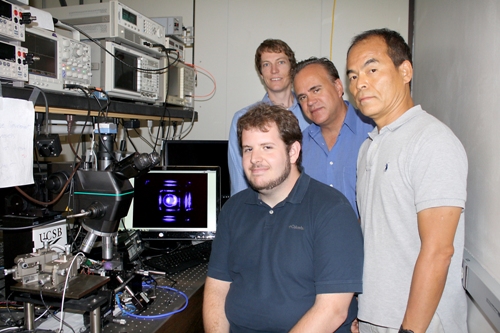A research team of LED pioneer Shuji Nakamura from the University of California, Santa Barbara (UCSB) has devised the first-of-its-kind m-plane gallium nitride semiconductor-based nonpolar vertical-cavity surface-emitting lasers (VCSELs).

Shuji Nakamura and his research group at UCSB demonstrate the first violet nonpolar m-plane VCSEL based on gallium nitride. Pictured left to right are Casey Holder, Daniel Feezell (back), Steven DenBaars and Shuji Nakamura. (credit:UCSB College of Engineering)
This development is a significant progress in VCSEL technology and paves the way to develop higher optical efficiency lasers at a lower production costs for a myriad of applications. VCSELs are advantageous over traditional edge-emitting laser technology in certain applications. For instance, on-wafer testing of VCSEL arrays in the production process can reduce expenses when compared to conventional edge-emitting lasers, which need more steps prior to their testing. VCSELs demonstrate circular and low divergence output beams and low threshold currents, and can be easily incorporated into two-dimensional arrays.
The nonpolar VCSEL platform also delivers high optical gain, which in turn facilitates improving optical efficiency of devices. Nakamura, a Professor of materials at UCSB, informed that this is the first nonpolar VCSEL, which is an important advancement in the laser diode technology field. The nonpolar VCSEL are better than traditional c-plane devices in many ways. One major benefit is the locking of the light polarization to one direction. These devices hold potential in several applications, including sensors, displays, and lighting, and in technology where small form-factor and energy efficiency are essential.
Rod Alferness, Dean of the College of Engineering at UCSB, commented that this demonstration of improved laser performance and cost-effectiveness will have a positive impact on next-generation lighting, mobile phones and flat panel displays.
Steven DenBaars, one of the members of the research team, stated that the nonpolar VCSEL may promote new applications and products such as pico-projectors for mobile cinema, smartphones, or even automotive lighting.
Disclaimer: The views expressed here are those of the author expressed in their private capacity and do not necessarily represent the views of AZoM.com Limited T/A AZoNetwork the owner and operator of this website. This disclaimer forms part of the Terms and conditions of use of this website.